Assignment on the Job Functions of Nursing
VerifiedAdded on 2021/01/01
|11
|3730
|265
AI Summary
Contribute Materials
Your contribution can guide someone’s learning journey. Share your
documents today.
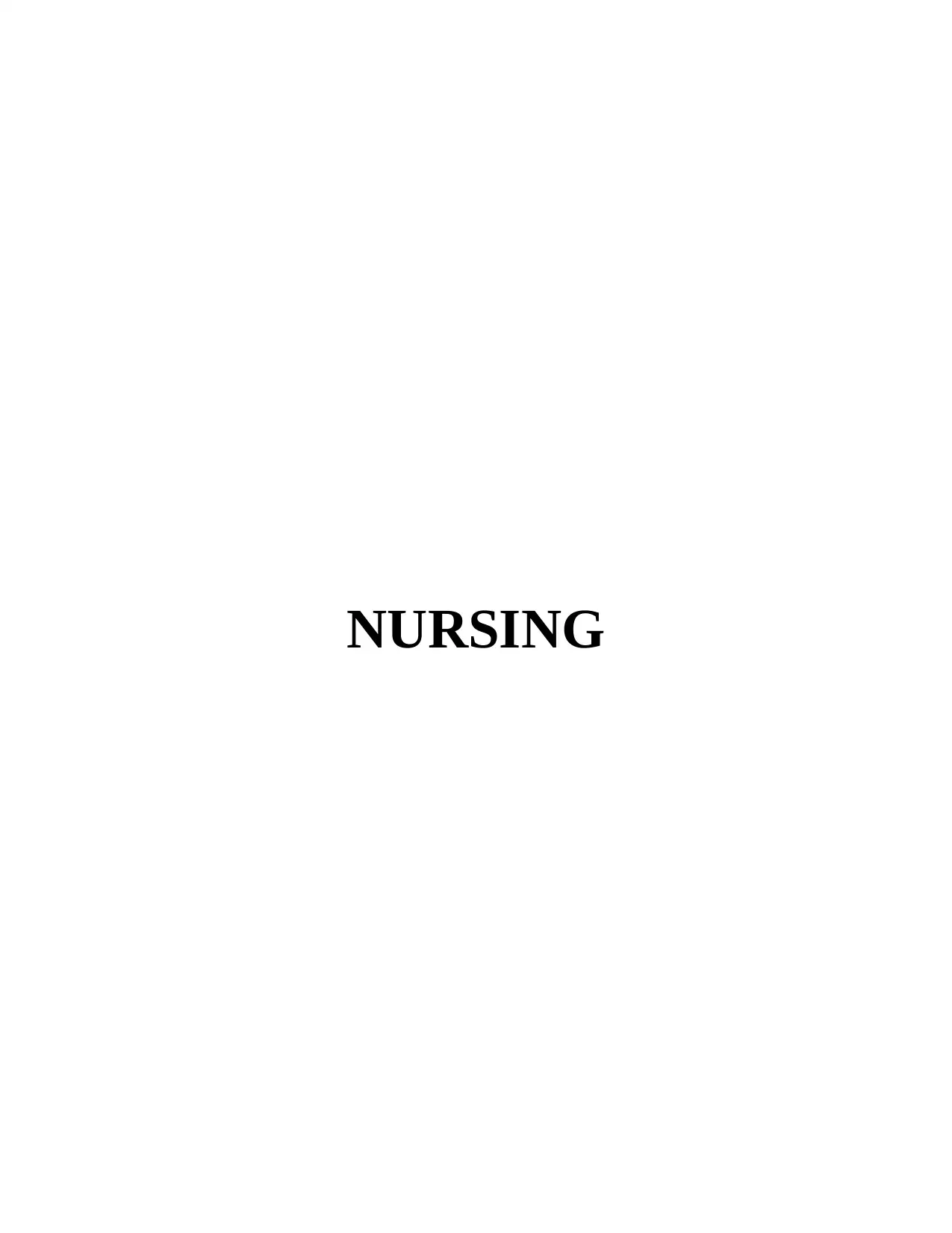
NURSING
Secure Best Marks with AI Grader
Need help grading? Try our AI Grader for instant feedback on your assignments.

Table of Contents
INTRODUCTION...........................................................................................................................1
MAIN BODY...................................................................................................................................1
1. Female Catheterization............................................................................................................1
2. Under water seal drainage.......................................................................................................3
3. Intravenous medication...........................................................................................................4
4. Complex wound management.................................................................................................6
CONCLUSION................................................................................................................................7
REFERENCES................................................................................................................................8
INTRODUCTION...........................................................................................................................1
MAIN BODY...................................................................................................................................1
1. Female Catheterization............................................................................................................1
2. Under water seal drainage.......................................................................................................3
3. Intravenous medication...........................................................................................................4
4. Complex wound management.................................................................................................6
CONCLUSION................................................................................................................................7
REFERENCES................................................................................................................................8

INTRODUCTION
Nursing is the critical job functions as it is patient centric approach and is directly related
to quality of care and safety for service users. It is the responsibility of health care organisation
to recruit the best practitioners in order to maintain quality of health and care practices. The
report will focus on 4 examples of different clinical practices, that is, female catheterization,
under water seal drainage, complex wound management and intravenous medication. However,
to develop critical understanding over clinical practices, the portfolio will outline description of
all 4 cases with the activities which are performed correctly. This analysis will assist in analysing
the improvement measures with specific motive.
However, the four skills in study will be based on specific category that is catheterization
will be focused on insertion of Foley catheter. Water seal drainage will be related to service user
with Coronary artery bypass grafting surgery. Intravenous medication will be focused on
antibiotics and complex wound management will be focused on diabetic patients. Thus, the
analysis of research will be based on secondary evidence where views of different author on
clinical practices will be discussed.
MAIN BODY
1. Female Catheterization
Female Catheterization is a critical process as it is related to insertion of medical devices
in human body in order to treat diseases. My experience on second week of placement is related
to Foley Catheter insertion of 65 years old aboriginal woman. The discomfort of woman was
analysed when she refused to take treatment from male nurse and therefore, I raised my hand to
proceed with insertion process. The process was new and I was doing it for the first time.
Therefore, one registered female nurse joined me for the process. The service users were anxious
and uncomfortable but it was my responsibility to calm her before proceeding in order to make
further process smooth. I came up with catheterization trolley which has Foley catheter of two
sizes that is 12 and 14. In addition, there was antiseptic solution, catheter bag, 10 ml of syringe
with sterilised water, lubricant, catheterization pack and sterile gloves (Urinary Catheterization,
2017). The best part of process was sizes of catheter which assisted me in easy insertion as per
comfort level of women.
1
Nursing is the critical job functions as it is patient centric approach and is directly related
to quality of care and safety for service users. It is the responsibility of health care organisation
to recruit the best practitioners in order to maintain quality of health and care practices. The
report will focus on 4 examples of different clinical practices, that is, female catheterization,
under water seal drainage, complex wound management and intravenous medication. However,
to develop critical understanding over clinical practices, the portfolio will outline description of
all 4 cases with the activities which are performed correctly. This analysis will assist in analysing
the improvement measures with specific motive.
However, the four skills in study will be based on specific category that is catheterization
will be focused on insertion of Foley catheter. Water seal drainage will be related to service user
with Coronary artery bypass grafting surgery. Intravenous medication will be focused on
antibiotics and complex wound management will be focused on diabetic patients. Thus, the
analysis of research will be based on secondary evidence where views of different author on
clinical practices will be discussed.
MAIN BODY
1. Female Catheterization
Female Catheterization is a critical process as it is related to insertion of medical devices
in human body in order to treat diseases. My experience on second week of placement is related
to Foley Catheter insertion of 65 years old aboriginal woman. The discomfort of woman was
analysed when she refused to take treatment from male nurse and therefore, I raised my hand to
proceed with insertion process. The process was new and I was doing it for the first time.
Therefore, one registered female nurse joined me for the process. The service users were anxious
and uncomfortable but it was my responsibility to calm her before proceeding in order to make
further process smooth. I came up with catheterization trolley which has Foley catheter of two
sizes that is 12 and 14. In addition, there was antiseptic solution, catheter bag, 10 ml of syringe
with sterilised water, lubricant, catheterization pack and sterile gloves (Urinary Catheterization,
2017). The best part of process was sizes of catheter which assisted me in easy insertion as per
comfort level of women.
1
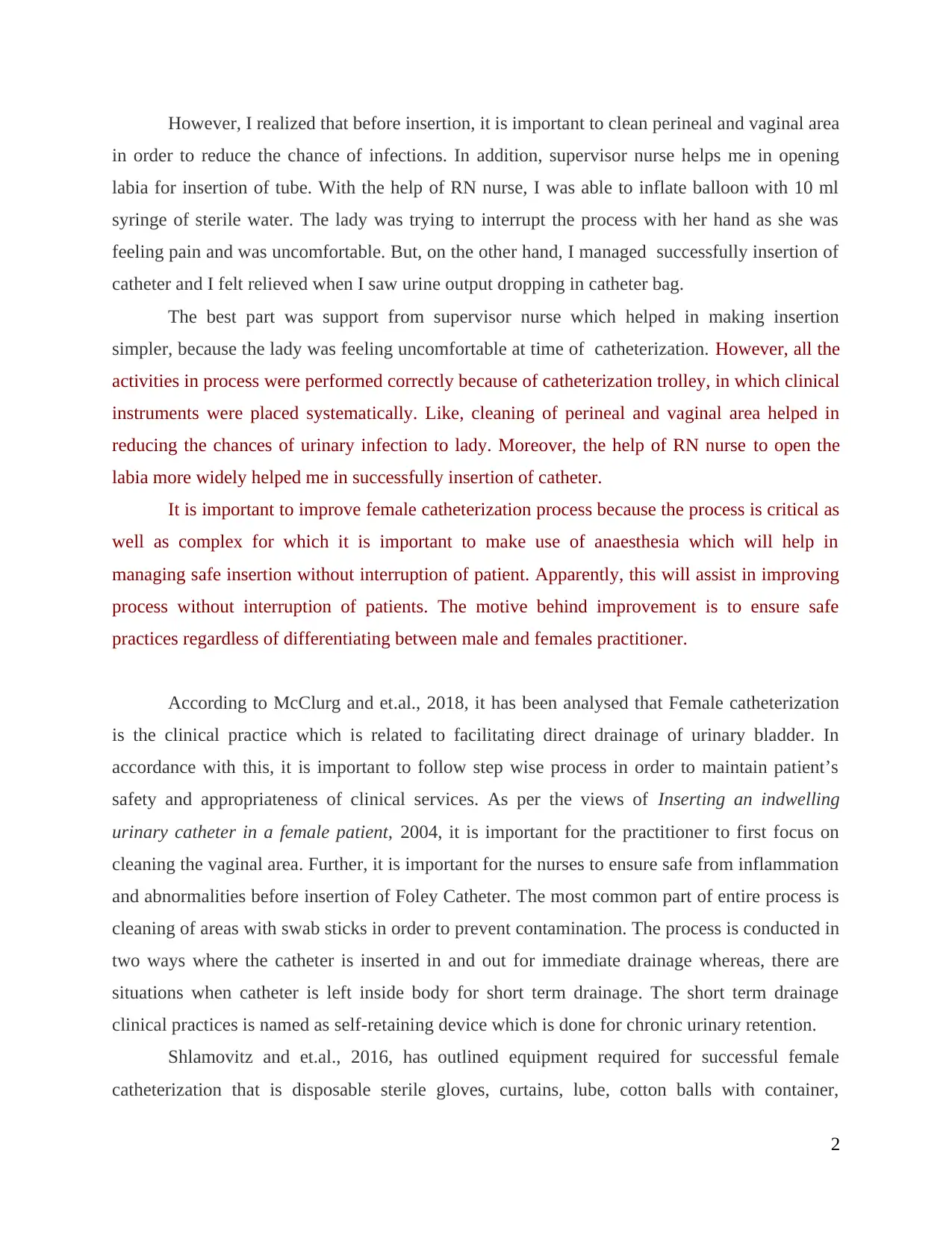
However, I realized that before insertion, it is important to clean perineal and vaginal area
in order to reduce the chance of infections. In addition, supervisor nurse helps me in opening
labia for insertion of tube. With the help of RN nurse, I was able to inflate balloon with 10 ml
syringe of sterile water. The lady was trying to interrupt the process with her hand as she was
feeling pain and was uncomfortable. But, on the other hand, I managed successfully insertion of
catheter and I felt relieved when I saw urine output dropping in catheter bag.
The best part was support from supervisor nurse which helped in making insertion
simpler, because the lady was feeling uncomfortable at time of catheterization. However, all the
activities in process were performed correctly because of catheterization trolley, in which clinical
instruments were placed systematically. Like, cleaning of perineal and vaginal area helped in
reducing the chances of urinary infection to lady. Moreover, the help of RN nurse to open the
labia more widely helped me in successfully insertion of catheter.
It is important to improve female catheterization process because the process is critical as
well as complex for which it is important to make use of anaesthesia which will help in
managing safe insertion without interruption of patient. Apparently, this will assist in improving
process without interruption of patients. The motive behind improvement is to ensure safe
practices regardless of differentiating between male and females practitioner.
According to McClurg and et.al., 2018, it has been analysed that Female catheterization
is the clinical practice which is related to facilitating direct drainage of urinary bladder. In
accordance with this, it is important to follow step wise process in order to maintain patient’s
safety and appropriateness of clinical services. As per the views of Inserting an indwelling
urinary catheter in a female patient, 2004, it is important for the practitioner to first focus on
cleaning the vaginal area. Further, it is important for the nurses to ensure safe from inflammation
and abnormalities before insertion of Foley Catheter. The most common part of entire process is
cleaning of areas with swab sticks in order to prevent contamination. The process is conducted in
two ways where the catheter is inserted in and out for immediate drainage whereas, there are
situations when catheter is left inside body for short term drainage. The short term drainage
clinical practices is named as self-retaining device which is done for chronic urinary retention.
Shlamovitz and et.al., 2016, has outlined equipment required for successful female
catheterization that is disposable sterile gloves, curtains, lube, cotton balls with container,
2
in order to reduce the chance of infections. In addition, supervisor nurse helps me in opening
labia for insertion of tube. With the help of RN nurse, I was able to inflate balloon with 10 ml
syringe of sterile water. The lady was trying to interrupt the process with her hand as she was
feeling pain and was uncomfortable. But, on the other hand, I managed successfully insertion of
catheter and I felt relieved when I saw urine output dropping in catheter bag.
The best part was support from supervisor nurse which helped in making insertion
simpler, because the lady was feeling uncomfortable at time of catheterization. However, all the
activities in process were performed correctly because of catheterization trolley, in which clinical
instruments were placed systematically. Like, cleaning of perineal and vaginal area helped in
reducing the chances of urinary infection to lady. Moreover, the help of RN nurse to open the
labia more widely helped me in successfully insertion of catheter.
It is important to improve female catheterization process because the process is critical as
well as complex for which it is important to make use of anaesthesia which will help in
managing safe insertion without interruption of patient. Apparently, this will assist in improving
process without interruption of patients. The motive behind improvement is to ensure safe
practices regardless of differentiating between male and females practitioner.
According to McClurg and et.al., 2018, it has been analysed that Female catheterization
is the clinical practice which is related to facilitating direct drainage of urinary bladder. In
accordance with this, it is important to follow step wise process in order to maintain patient’s
safety and appropriateness of clinical services. As per the views of Inserting an indwelling
urinary catheter in a female patient, 2004, it is important for the practitioner to first focus on
cleaning the vaginal area. Further, it is important for the nurses to ensure safe from inflammation
and abnormalities before insertion of Foley Catheter. The most common part of entire process is
cleaning of areas with swab sticks in order to prevent contamination. The process is conducted in
two ways where the catheter is inserted in and out for immediate drainage whereas, there are
situations when catheter is left inside body for short term drainage. The short term drainage
clinical practices is named as self-retaining device which is done for chronic urinary retention.
Shlamovitz and et.al., 2016, has outlined equipment required for successful female
catheterization that is disposable sterile gloves, curtains, lube, cotton balls with container,
2
Secure Best Marks with AI Grader
Need help grading? Try our AI Grader for instant feedback on your assignments.

forceps (2) and pre-filled 10ml syringe with sterile water which is used to inflate the balloon. It is
important for the nurses to use sterile specimen container for collecting urine sample. In addition,
the basic requirements are sterile water, adhesive tape, urine drainage bag and chlorhexidine 2%
aqueous solution. Apparently, it is important for the practitioner to make use of small size of
catheter which helps in maintaining adequacy in urine drainage. Like; 12 to 14 for females
draining clear urine.
2. Under water seal drainage
Underwater seal is an effective clinical tool which is used to prevent backflow of air and
fluid into peural cavity. In this setting, it is important for the nurses to ensure hand hygiene, use
of sterile gloves, secure drain with the help of tubing, and securing all internal connection with
cable ties.
At time of seventh week of clinical practices, I came across the case where 14 year old
aboriginal girl Jane was presented in hospital for chest drain. She was suffering from severe
chest pain, dry cough fever, difficult in breathing and persistent hiccups. In accordance, to
situation UWSD was performed by physicians. Physicians allotted me duty in surgical ward for
taking care of patient having UWSD. To enable safe practices I used sterile gloves and mask in
order to prevent contamination and infection (Chest Drain Management, 2016). The girl was
critical and therefore physician asked me to take special care for which I ensured proper care,
safety, suction, regular dressing, tubing, daily assessment and proper documentation.
However, to enable safe care I ensured mild and bacterial room where no outsider was
allowed without hand hygienic and mask. Further, I was following output chart which comprise
details of medication such as blood and fluid (pneumothorax, haemothorax) bubbling, swinging.
In addition, my focus was on water in the bottle, loops of tubing, suction, level of bottle
below chest and proper use of clamping
As per the experience of nursing management of 14 years old girl with USWD, it can be
said that there are various improvement measures which needs to be considered because under
water seal drainage which is an critical situation. Further, hand hygiene and following of output
chart plays an important role in managing safe patient care (Asti and et.al., 2018). Further, as per
the care tubing, clamping and looping was performed correctly.
In accordance to nursing management of USWD, it is essential of the practitioner to
focus on bottle/unit, position of unit, swinging, drainage assessment and bubbling. Apparently, in
3
important for the nurses to use sterile specimen container for collecting urine sample. In addition,
the basic requirements are sterile water, adhesive tape, urine drainage bag and chlorhexidine 2%
aqueous solution. Apparently, it is important for the practitioner to make use of small size of
catheter which helps in maintaining adequacy in urine drainage. Like; 12 to 14 for females
draining clear urine.
2. Under water seal drainage
Underwater seal is an effective clinical tool which is used to prevent backflow of air and
fluid into peural cavity. In this setting, it is important for the nurses to ensure hand hygiene, use
of sterile gloves, secure drain with the help of tubing, and securing all internal connection with
cable ties.
At time of seventh week of clinical practices, I came across the case where 14 year old
aboriginal girl Jane was presented in hospital for chest drain. She was suffering from severe
chest pain, dry cough fever, difficult in breathing and persistent hiccups. In accordance, to
situation UWSD was performed by physicians. Physicians allotted me duty in surgical ward for
taking care of patient having UWSD. To enable safe practices I used sterile gloves and mask in
order to prevent contamination and infection (Chest Drain Management, 2016). The girl was
critical and therefore physician asked me to take special care for which I ensured proper care,
safety, suction, regular dressing, tubing, daily assessment and proper documentation.
However, to enable safe care I ensured mild and bacterial room where no outsider was
allowed without hand hygienic and mask. Further, I was following output chart which comprise
details of medication such as blood and fluid (pneumothorax, haemothorax) bubbling, swinging.
In addition, my focus was on water in the bottle, loops of tubing, suction, level of bottle
below chest and proper use of clamping
As per the experience of nursing management of 14 years old girl with USWD, it can be
said that there are various improvement measures which needs to be considered because under
water seal drainage which is an critical situation. Further, hand hygiene and following of output
chart plays an important role in managing safe patient care (Asti and et.al., 2018). Further, as per
the care tubing, clamping and looping was performed correctly.
In accordance to nursing management of USWD, it is essential of the practitioner to
focus on bottle/unit, position of unit, swinging, drainage assessment and bubbling. Apparently, in
3
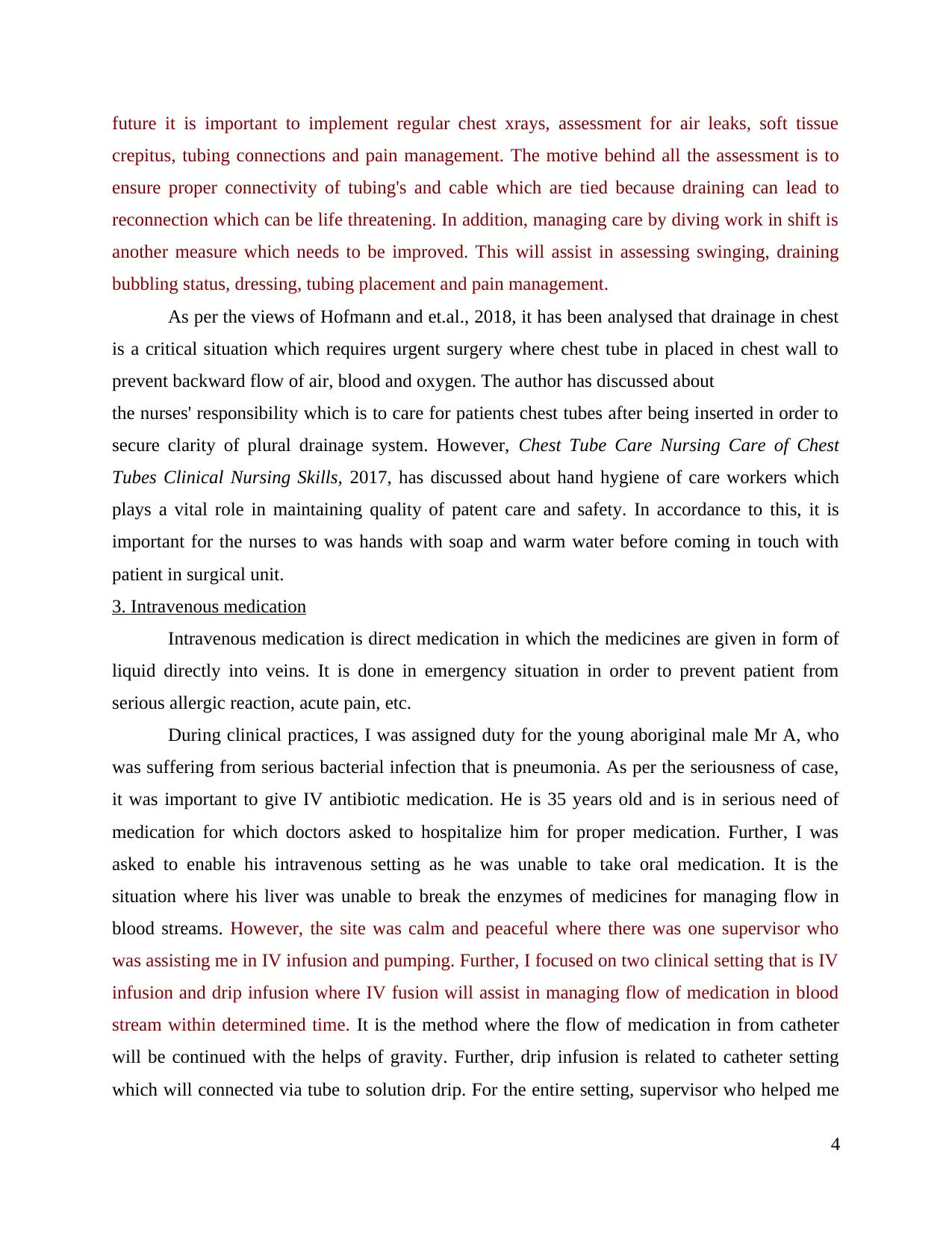
future it is important to implement regular chest xrays, assessment for air leaks, soft tissue
crepitus, tubing connections and pain management. The motive behind all the assessment is to
ensure proper connectivity of tubing's and cable which are tied because draining can lead to
reconnection which can be life threatening. In addition, managing care by diving work in shift is
another measure which needs to be improved. This will assist in assessing swinging, draining
bubbling status, dressing, tubing placement and pain management.
As per the views of Hofmann and et.al., 2018, it has been analysed that drainage in chest
is a critical situation which requires urgent surgery where chest tube in placed in chest wall to
prevent backward flow of air, blood and oxygen. The author has discussed about
the nurses' responsibility which is to care for patients chest tubes after being inserted in order to
secure clarity of plural drainage system. However, Chest Tube Care Nursing Care of Chest
Tubes Clinical Nursing Skills, 2017, has discussed about hand hygiene of care workers which
plays a vital role in maintaining quality of patent care and safety. In accordance to this, it is
important for the nurses to was hands with soap and warm water before coming in touch with
patient in surgical unit.
3. Intravenous medication
Intravenous medication is direct medication in which the medicines are given in form of
liquid directly into veins. It is done in emergency situation in order to prevent patient from
serious allergic reaction, acute pain, etc.
During clinical practices, I was assigned duty for the young aboriginal male Mr A, who
was suffering from serious bacterial infection that is pneumonia. As per the seriousness of case,
it was important to give IV antibiotic medication. He is 35 years old and is in serious need of
medication for which doctors asked to hospitalize him for proper medication. Further, I was
asked to enable his intravenous setting as he was unable to take oral medication. It is the
situation where his liver was unable to break the enzymes of medicines for managing flow in
blood streams. However, the site was calm and peaceful where there was one supervisor who
was assisting me in IV infusion and pumping. Further, I focused on two clinical setting that is IV
infusion and drip infusion where IV fusion will assist in managing flow of medication in blood
stream within determined time. It is the method where the flow of medication in from catheter
will be continued with the helps of gravity. Further, drip infusion is related to catheter setting
which will connected via tube to solution drip. For the entire setting, supervisor who helped me
4
crepitus, tubing connections and pain management. The motive behind all the assessment is to
ensure proper connectivity of tubing's and cable which are tied because draining can lead to
reconnection which can be life threatening. In addition, managing care by diving work in shift is
another measure which needs to be improved. This will assist in assessing swinging, draining
bubbling status, dressing, tubing placement and pain management.
As per the views of Hofmann and et.al., 2018, it has been analysed that drainage in chest
is a critical situation which requires urgent surgery where chest tube in placed in chest wall to
prevent backward flow of air, blood and oxygen. The author has discussed about
the nurses' responsibility which is to care for patients chest tubes after being inserted in order to
secure clarity of plural drainage system. However, Chest Tube Care Nursing Care of Chest
Tubes Clinical Nursing Skills, 2017, has discussed about hand hygiene of care workers which
plays a vital role in maintaining quality of patent care and safety. In accordance to this, it is
important for the nurses to was hands with soap and warm water before coming in touch with
patient in surgical unit.
3. Intravenous medication
Intravenous medication is direct medication in which the medicines are given in form of
liquid directly into veins. It is done in emergency situation in order to prevent patient from
serious allergic reaction, acute pain, etc.
During clinical practices, I was assigned duty for the young aboriginal male Mr A, who
was suffering from serious bacterial infection that is pneumonia. As per the seriousness of case,
it was important to give IV antibiotic medication. He is 35 years old and is in serious need of
medication for which doctors asked to hospitalize him for proper medication. Further, I was
asked to enable his intravenous setting as he was unable to take oral medication. It is the
situation where his liver was unable to break the enzymes of medicines for managing flow in
blood streams. However, the site was calm and peaceful where there was one supervisor who
was assisting me in IV infusion and pumping. Further, I focused on two clinical setting that is IV
infusion and drip infusion where IV fusion will assist in managing flow of medication in blood
stream within determined time. It is the method where the flow of medication in from catheter
will be continued with the helps of gravity. Further, drip infusion is related to catheter setting
which will connected via tube to solution drip. For the entire setting, supervisor who helped me
4
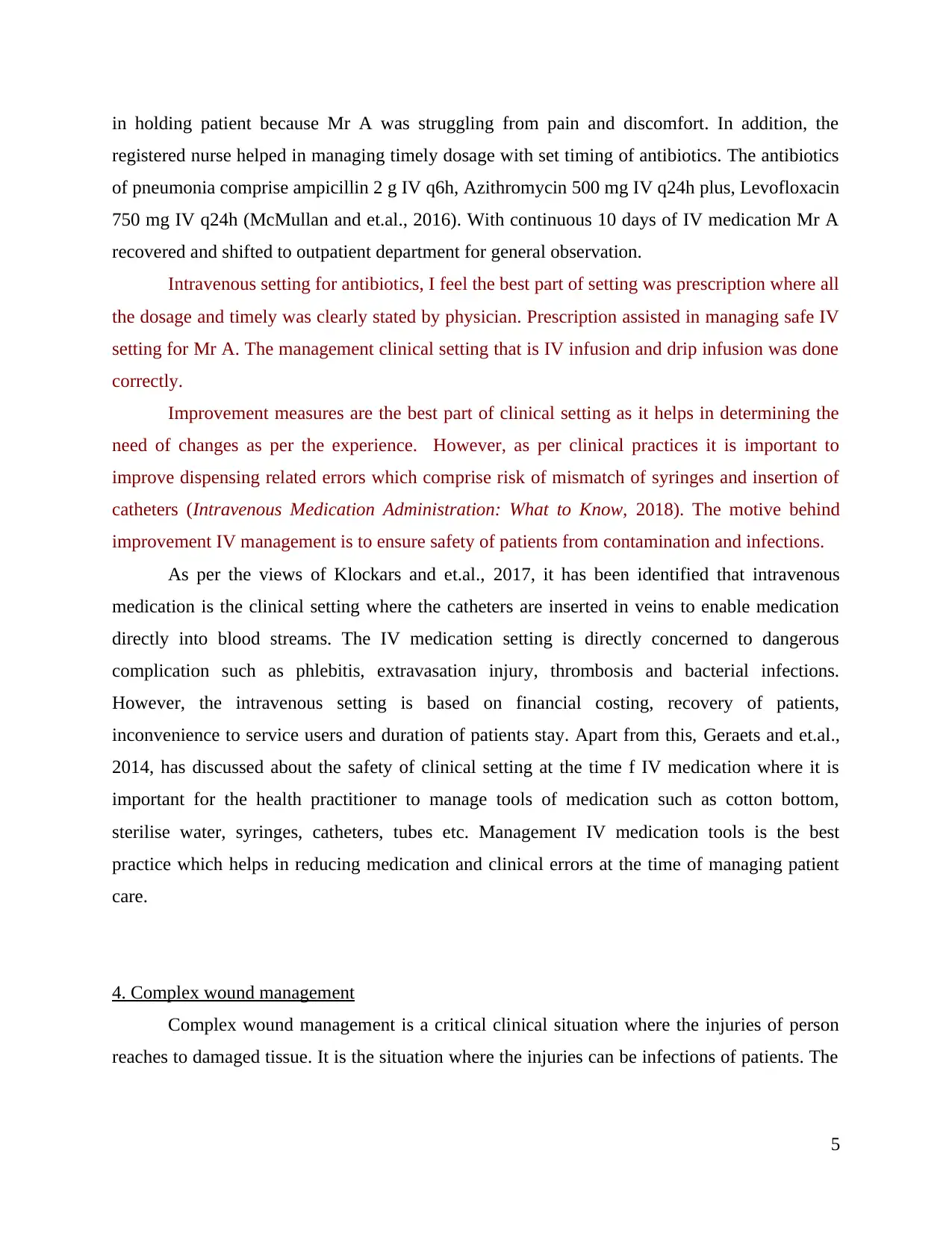
in holding patient because Mr A was struggling from pain and discomfort. In addition, the
registered nurse helped in managing timely dosage with set timing of antibiotics. The antibiotics
of pneumonia comprise ampicillin 2 g IV q6h, Azithromycin 500 mg IV q24h plus, Levofloxacin
750 mg IV q24h (McMullan and et.al., 2016). With continuous 10 days of IV medication Mr A
recovered and shifted to outpatient department for general observation.
Intravenous setting for antibiotics, I feel the best part of setting was prescription where all
the dosage and timely was clearly stated by physician. Prescription assisted in managing safe IV
setting for Mr A. The management clinical setting that is IV infusion and drip infusion was done
correctly.
Improvement measures are the best part of clinical setting as it helps in determining the
need of changes as per the experience. However, as per clinical practices it is important to
improve dispensing related errors which comprise risk of mismatch of syringes and insertion of
catheters (Intravenous Medication Administration: What to Know, 2018). The motive behind
improvement IV management is to ensure safety of patients from contamination and infections.
As per the views of Klockars and et.al., 2017, it has been identified that intravenous
medication is the clinical setting where the catheters are inserted in veins to enable medication
directly into blood streams. The IV medication setting is directly concerned to dangerous
complication such as phlebitis, extravasation injury, thrombosis and bacterial infections.
However, the intravenous setting is based on financial costing, recovery of patients,
inconvenience to service users and duration of patients stay. Apart from this, Geraets and et.al.,
2014, has discussed about the safety of clinical setting at the time f IV medication where it is
important for the health practitioner to manage tools of medication such as cotton bottom,
sterilise water, syringes, catheters, tubes etc. Management IV medication tools is the best
practice which helps in reducing medication and clinical errors at the time of managing patient
care.
4. Complex wound management
Complex wound management is a critical clinical situation where the injuries of person
reaches to damaged tissue. It is the situation where the injuries can be infections of patients. The
5
registered nurse helped in managing timely dosage with set timing of antibiotics. The antibiotics
of pneumonia comprise ampicillin 2 g IV q6h, Azithromycin 500 mg IV q24h plus, Levofloxacin
750 mg IV q24h (McMullan and et.al., 2016). With continuous 10 days of IV medication Mr A
recovered and shifted to outpatient department for general observation.
Intravenous setting for antibiotics, I feel the best part of setting was prescription where all
the dosage and timely was clearly stated by physician. Prescription assisted in managing safe IV
setting for Mr A. The management clinical setting that is IV infusion and drip infusion was done
correctly.
Improvement measures are the best part of clinical setting as it helps in determining the
need of changes as per the experience. However, as per clinical practices it is important to
improve dispensing related errors which comprise risk of mismatch of syringes and insertion of
catheters (Intravenous Medication Administration: What to Know, 2018). The motive behind
improvement IV management is to ensure safety of patients from contamination and infections.
As per the views of Klockars and et.al., 2017, it has been identified that intravenous
medication is the clinical setting where the catheters are inserted in veins to enable medication
directly into blood streams. The IV medication setting is directly concerned to dangerous
complication such as phlebitis, extravasation injury, thrombosis and bacterial infections.
However, the intravenous setting is based on financial costing, recovery of patients,
inconvenience to service users and duration of patients stay. Apart from this, Geraets and et.al.,
2014, has discussed about the safety of clinical setting at the time f IV medication where it is
important for the health practitioner to manage tools of medication such as cotton bottom,
sterilise water, syringes, catheters, tubes etc. Management IV medication tools is the best
practice which helps in reducing medication and clinical errors at the time of managing patient
care.
4. Complex wound management
Complex wound management is a critical clinical situation where the injuries of person
reaches to damaged tissue. It is the situation where the injuries can be infections of patients. The
5
Paraphrase This Document
Need a fresh take? Get an instant paraphrase of this document with our AI Paraphraser
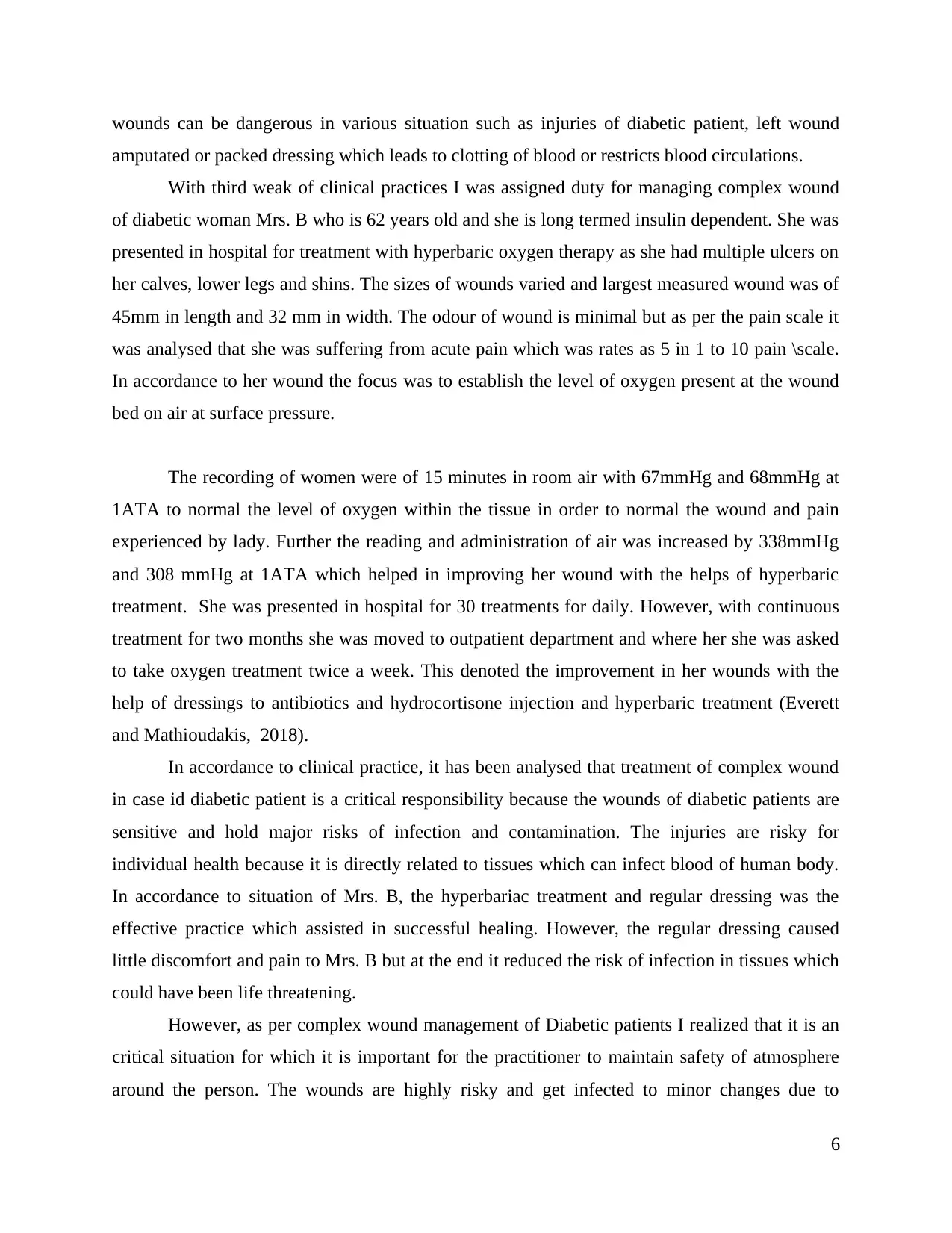
wounds can be dangerous in various situation such as injuries of diabetic patient, left wound
amputated or packed dressing which leads to clotting of blood or restricts blood circulations.
With third weak of clinical practices I was assigned duty for managing complex wound
of diabetic woman Mrs. B who is 62 years old and she is long termed insulin dependent. She was
presented in hospital for treatment with hyperbaric oxygen therapy as she had multiple ulcers on
her calves, lower legs and shins. The sizes of wounds varied and largest measured wound was of
45mm in length and 32 mm in width. The odour of wound is minimal but as per the pain scale it
was analysed that she was suffering from acute pain which was rates as 5 in 1 to 10 pain \scale.
In accordance to her wound the focus was to establish the level of oxygen present at the wound
bed on air at surface pressure.
The recording of women were of 15 minutes in room air with 67mmHg and 68mmHg at
1ATA to normal the level of oxygen within the tissue in order to normal the wound and pain
experienced by lady. Further the reading and administration of air was increased by 338mmHg
and 308 mmHg at 1ATA which helped in improving her wound with the helps of hyperbaric
treatment. She was presented in hospital for 30 treatments for daily. However, with continuous
treatment for two months she was moved to outpatient department and where her she was asked
to take oxygen treatment twice a week. This denoted the improvement in her wounds with the
help of dressings to antibiotics and hydrocortisone injection and hyperbaric treatment (Everett
and Mathioudakis, 2018).
In accordance to clinical practice, it has been analysed that treatment of complex wound
in case id diabetic patient is a critical responsibility because the wounds of diabetic patients are
sensitive and hold major risks of infection and contamination. The injuries are risky for
individual health because it is directly related to tissues which can infect blood of human body.
In accordance to situation of Mrs. B, the hyperbariac treatment and regular dressing was the
effective practice which assisted in successful healing. However, the regular dressing caused
little discomfort and pain to Mrs. B but at the end it reduced the risk of infection in tissues which
could have been life threatening.
However, as per complex wound management of Diabetic patients I realized that it is an
critical situation for which it is important for the practitioner to maintain safety of atmosphere
around the person. The wounds are highly risky and get infected to minor changes due to
6
amputated or packed dressing which leads to clotting of blood or restricts blood circulations.
With third weak of clinical practices I was assigned duty for managing complex wound
of diabetic woman Mrs. B who is 62 years old and she is long termed insulin dependent. She was
presented in hospital for treatment with hyperbaric oxygen therapy as she had multiple ulcers on
her calves, lower legs and shins. The sizes of wounds varied and largest measured wound was of
45mm in length and 32 mm in width. The odour of wound is minimal but as per the pain scale it
was analysed that she was suffering from acute pain which was rates as 5 in 1 to 10 pain \scale.
In accordance to her wound the focus was to establish the level of oxygen present at the wound
bed on air at surface pressure.
The recording of women were of 15 minutes in room air with 67mmHg and 68mmHg at
1ATA to normal the level of oxygen within the tissue in order to normal the wound and pain
experienced by lady. Further the reading and administration of air was increased by 338mmHg
and 308 mmHg at 1ATA which helped in improving her wound with the helps of hyperbaric
treatment. She was presented in hospital for 30 treatments for daily. However, with continuous
treatment for two months she was moved to outpatient department and where her she was asked
to take oxygen treatment twice a week. This denoted the improvement in her wounds with the
help of dressings to antibiotics and hydrocortisone injection and hyperbaric treatment (Everett
and Mathioudakis, 2018).
In accordance to clinical practice, it has been analysed that treatment of complex wound
in case id diabetic patient is a critical responsibility because the wounds of diabetic patients are
sensitive and hold major risks of infection and contamination. The injuries are risky for
individual health because it is directly related to tissues which can infect blood of human body.
In accordance to situation of Mrs. B, the hyperbariac treatment and regular dressing was the
effective practice which assisted in successful healing. However, the regular dressing caused
little discomfort and pain to Mrs. B but at the end it reduced the risk of infection in tissues which
could have been life threatening.
However, as per complex wound management of Diabetic patients I realized that it is an
critical situation for which it is important for the practitioner to maintain safety of atmosphere
around the person. The wounds are highly risky and get infected to minor changes due to
6
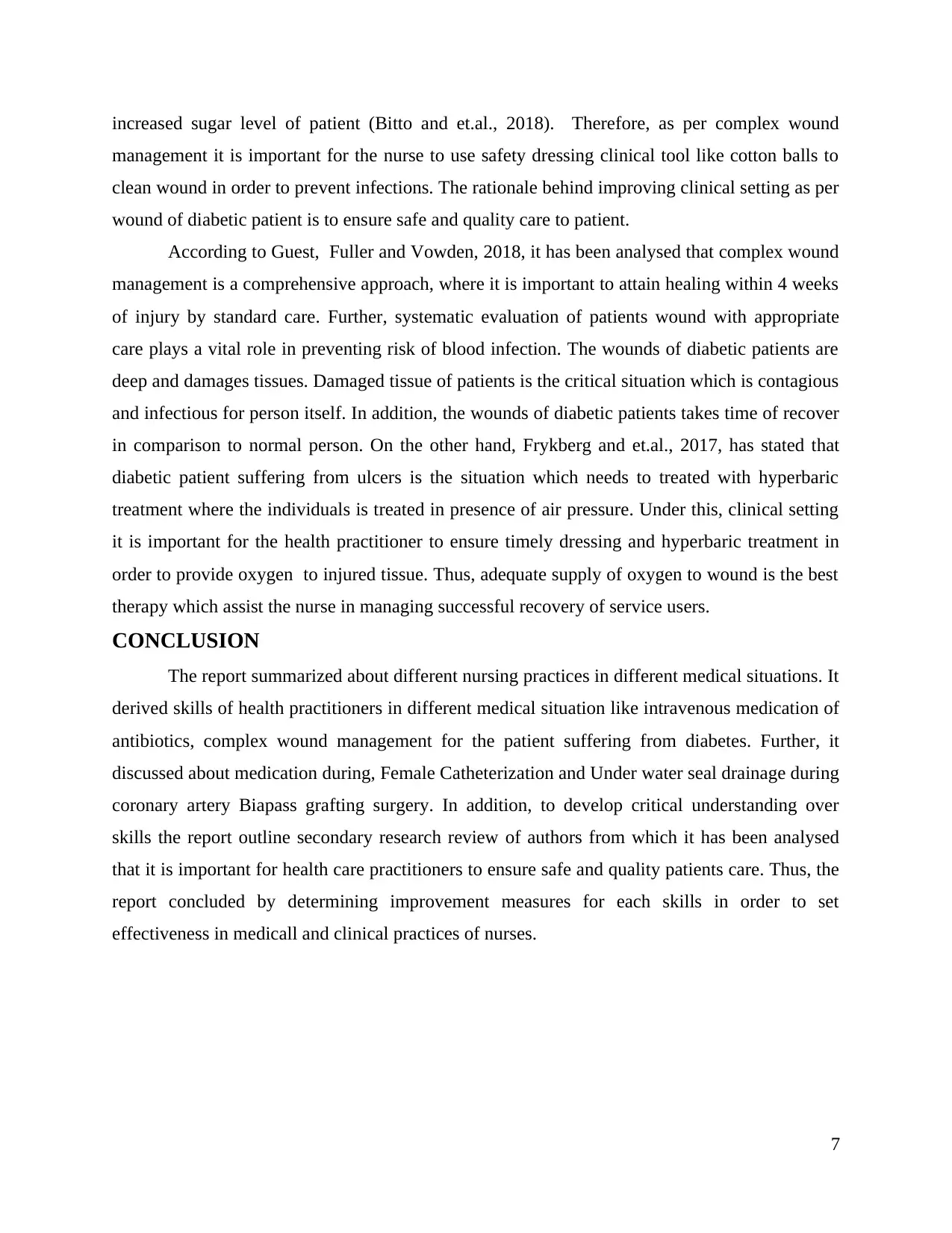
increased sugar level of patient (Bitto and et.al., 2018). Therefore, as per complex wound
management it is important for the nurse to use safety dressing clinical tool like cotton balls to
clean wound in order to prevent infections. The rationale behind improving clinical setting as per
wound of diabetic patient is to ensure safe and quality care to patient.
According to Guest, Fuller and Vowden, 2018, it has been analysed that complex wound
management is a comprehensive approach, where it is important to attain healing within 4 weeks
of injury by standard care. Further, systematic evaluation of patients wound with appropriate
care plays a vital role in preventing risk of blood infection. The wounds of diabetic patients are
deep and damages tissues. Damaged tissue of patients is the critical situation which is contagious
and infectious for person itself. In addition, the wounds of diabetic patients takes time of recover
in comparison to normal person. On the other hand, Frykberg and et.al., 2017, has stated that
diabetic patient suffering from ulcers is the situation which needs to treated with hyperbaric
treatment where the individuals is treated in presence of air pressure. Under this, clinical setting
it is important for the health practitioner to ensure timely dressing and hyperbaric treatment in
order to provide oxygen to injured tissue. Thus, adequate supply of oxygen to wound is the best
therapy which assist the nurse in managing successful recovery of service users.
CONCLUSION
The report summarized about different nursing practices in different medical situations. It
derived skills of health practitioners in different medical situation like intravenous medication of
antibiotics, complex wound management for the patient suffering from diabetes. Further, it
discussed about medication during, Female Catheterization and Under water seal drainage during
coronary artery Biapass grafting surgery. In addition, to develop critical understanding over
skills the report outline secondary research review of authors from which it has been analysed
that it is important for health care practitioners to ensure safe and quality patients care. Thus, the
report concluded by determining improvement measures for each skills in order to set
effectiveness in medicall and clinical practices of nurses.
7
management it is important for the nurse to use safety dressing clinical tool like cotton balls to
clean wound in order to prevent infections. The rationale behind improving clinical setting as per
wound of diabetic patient is to ensure safe and quality care to patient.
According to Guest, Fuller and Vowden, 2018, it has been analysed that complex wound
management is a comprehensive approach, where it is important to attain healing within 4 weeks
of injury by standard care. Further, systematic evaluation of patients wound with appropriate
care plays a vital role in preventing risk of blood infection. The wounds of diabetic patients are
deep and damages tissues. Damaged tissue of patients is the critical situation which is contagious
and infectious for person itself. In addition, the wounds of diabetic patients takes time of recover
in comparison to normal person. On the other hand, Frykberg and et.al., 2017, has stated that
diabetic patient suffering from ulcers is the situation which needs to treated with hyperbaric
treatment where the individuals is treated in presence of air pressure. Under this, clinical setting
it is important for the health practitioner to ensure timely dressing and hyperbaric treatment in
order to provide oxygen to injured tissue. Thus, adequate supply of oxygen to wound is the best
therapy which assist the nurse in managing successful recovery of service users.
CONCLUSION
The report summarized about different nursing practices in different medical situations. It
derived skills of health practitioners in different medical situation like intravenous medication of
antibiotics, complex wound management for the patient suffering from diabetes. Further, it
discussed about medication during, Female Catheterization and Under water seal drainage during
coronary artery Biapass grafting surgery. In addition, to develop critical understanding over
skills the report outline secondary research review of authors from which it has been analysed
that it is important for health care practitioners to ensure safe and quality patients care. Thus, the
report concluded by determining improvement measures for each skills in order to set
effectiveness in medicall and clinical practices of nurses.
7

REFERENCES
Books and Journals
Asti, E. and et.al., 2018. Transhiatal chest drainage after hybrid Ivor Lewis esophagectomy:
Proof of concept study. Journal of Laparoendoscopic & Advanced Surgical Techniques.
28(4). pp.429-433.
Bitto, A. and et.al., 2018. Activation of the EPOR-β common receptor complex by cibinetide
ameliorates impaired wound healing in mice with genetic diabetes. Biochimica et
Biophysica Acta (BBA)-Molecular Basis of Disease. 1864(2). pp.632-639.
Everett, E. and Mathioudakis, N., 2018. Update on management of diabetic foot ulcers. Annals of
the New York Academy of Sciences. 1411(1). pp.153-165.
Frykberg, R.G. and et.al., 2017. A prospective, multicentre, open‐label, single‐arm clinical trial
for treatment of chronic complex diabetic foot wounds with exposed tendon and/or
bone: positive clinical outcomes of viable cryopreserved human placental membrane.
International wound journal. 14(3). pp.569-577.
Geraets, L. and et.al., 2014. Tissue distribution and elimination after oral and intravenous
administration of different titanium dioxide nanoparticles in rats. Particle and fibre
toxicology. 11(1). p.30.
Guest, J.F., Fuller, G.W. and Vowden, P., 2018. Diabetic foot ulcer management in clinical
practice in the UK: costs and outcomes. International wound journal, 15(1), pp.43-52.
Hofmann, S. and et.al., 2018. The Influence of Dynamically Regulated, Intermittently Regulated
Active Chest Drainage Units Compared to Conventional Vacuum-Driven Systems on
the Early Postoperative Outcome after Cardiac Surgery. The Thoracic and
Cardiovascular Surgeon. 66(S 01). pp.DGTHG-KV88.
Klockars, A. and et.al., 2017. Intravenous administration of oxytocin in rats acutely decreases
deprivation-induced chow intake, but it fails to affect consumption of palatable
solutions. Peptides. 93. pp.13-19.
McClurg, D. and et.al., 2018. Participant experiences of clean intermittent self-catheterisation,
urinary tract infections and antibiotic use on the ANTIC trial–A qualitative study.
International journal of nursing studies. 81. pp.1-7.
8
Books and Journals
Asti, E. and et.al., 2018. Transhiatal chest drainage after hybrid Ivor Lewis esophagectomy:
Proof of concept study. Journal of Laparoendoscopic & Advanced Surgical Techniques.
28(4). pp.429-433.
Bitto, A. and et.al., 2018. Activation of the EPOR-β common receptor complex by cibinetide
ameliorates impaired wound healing in mice with genetic diabetes. Biochimica et
Biophysica Acta (BBA)-Molecular Basis of Disease. 1864(2). pp.632-639.
Everett, E. and Mathioudakis, N., 2018. Update on management of diabetic foot ulcers. Annals of
the New York Academy of Sciences. 1411(1). pp.153-165.
Frykberg, R.G. and et.al., 2017. A prospective, multicentre, open‐label, single‐arm clinical trial
for treatment of chronic complex diabetic foot wounds with exposed tendon and/or
bone: positive clinical outcomes of viable cryopreserved human placental membrane.
International wound journal. 14(3). pp.569-577.
Geraets, L. and et.al., 2014. Tissue distribution and elimination after oral and intravenous
administration of different titanium dioxide nanoparticles in rats. Particle and fibre
toxicology. 11(1). p.30.
Guest, J.F., Fuller, G.W. and Vowden, P., 2018. Diabetic foot ulcer management in clinical
practice in the UK: costs and outcomes. International wound journal, 15(1), pp.43-52.
Hofmann, S. and et.al., 2018. The Influence of Dynamically Regulated, Intermittently Regulated
Active Chest Drainage Units Compared to Conventional Vacuum-Driven Systems on
the Early Postoperative Outcome after Cardiac Surgery. The Thoracic and
Cardiovascular Surgeon. 66(S 01). pp.DGTHG-KV88.
Klockars, A. and et.al., 2017. Intravenous administration of oxytocin in rats acutely decreases
deprivation-induced chow intake, but it fails to affect consumption of palatable
solutions. Peptides. 93. pp.13-19.
McClurg, D. and et.al., 2018. Participant experiences of clean intermittent self-catheterisation,
urinary tract infections and antibiotic use on the ANTIC trial–A qualitative study.
International journal of nursing studies. 81. pp.1-7.
8
Secure Best Marks with AI Grader
Need help grading? Try our AI Grader for instant feedback on your assignments.
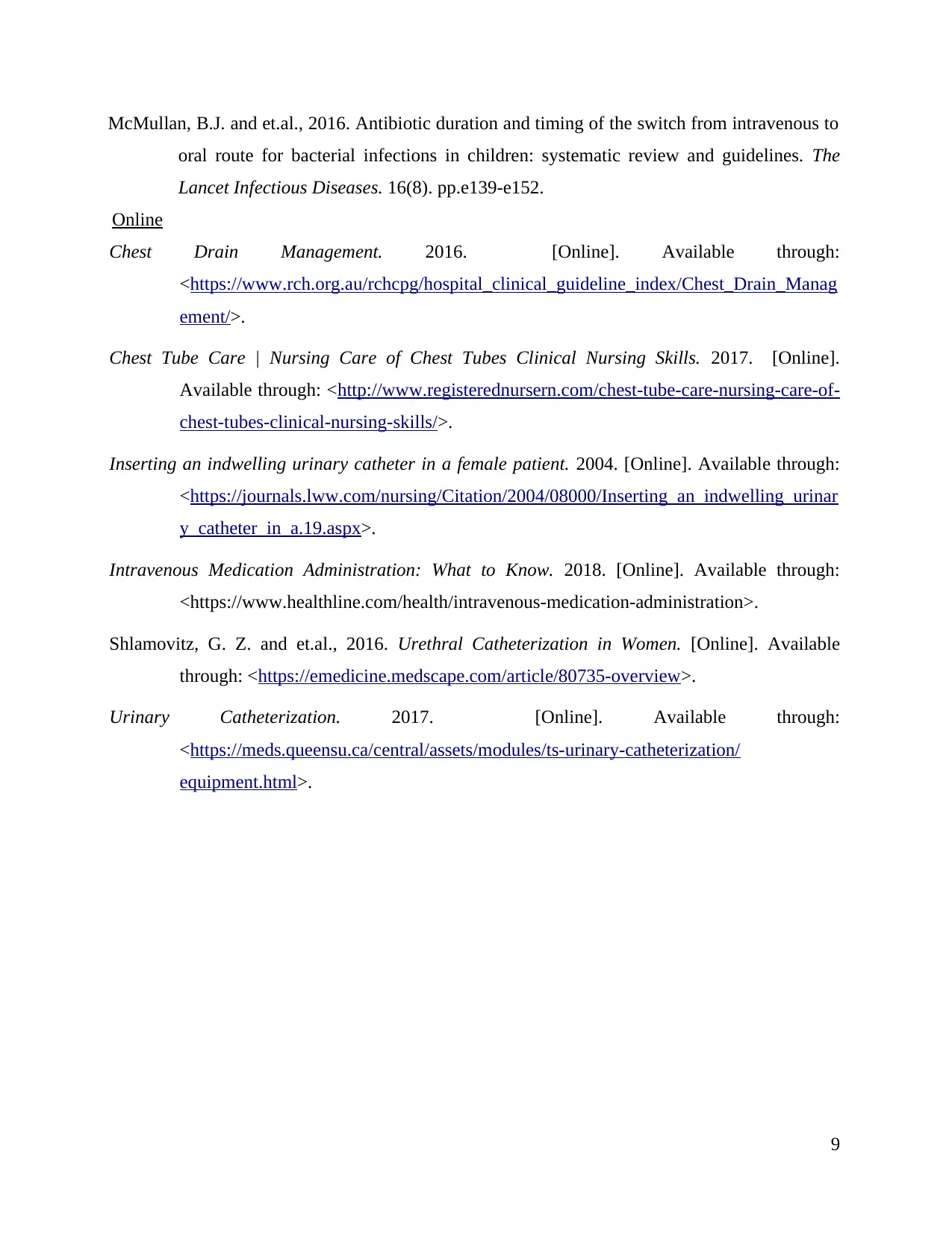
McMullan, B.J. and et.al., 2016. Antibiotic duration and timing of the switch from intravenous to
oral route for bacterial infections in children: systematic review and guidelines. The
Lancet Infectious Diseases. 16(8). pp.e139-e152.
Online
Chest Drain Management. 2016. [Online]. Available through:
<https://www.rch.org.au/rchcpg/hospital_clinical_guideline_index/Chest_Drain_Manag
ement/>.
Chest Tube Care | Nursing Care of Chest Tubes Clinical Nursing Skills. 2017. [Online].
Available through: <http://www.registerednursern.com/chest-tube-care-nursing-care-of-
chest-tubes-clinical-nursing-skills/>.
Inserting an indwelling urinary catheter in a female patient. 2004. [Online]. Available through:
<https://journals.lww.com/nursing/Citation/2004/08000/Inserting_an_indwelling_urinar
y_catheter_in_a.19.aspx>.
Intravenous Medication Administration: What to Know. 2018. [Online]. Available through:
<https://www.healthline.com/health/intravenous-medication-administration>.
Shlamovitz, G. Z. and et.al., 2016. Urethral Catheterization in Women. [Online]. Available
through: <https://emedicine.medscape.com/article/80735-overview>.
Urinary Catheterization. 2017. [Online]. Available through:
<https://meds.queensu.ca/central/assets/modules/ts-urinary-catheterization/
equipment.html>.
9
oral route for bacterial infections in children: systematic review and guidelines. The
Lancet Infectious Diseases. 16(8). pp.e139-e152.
Online
Chest Drain Management. 2016. [Online]. Available through:
<https://www.rch.org.au/rchcpg/hospital_clinical_guideline_index/Chest_Drain_Manag
ement/>.
Chest Tube Care | Nursing Care of Chest Tubes Clinical Nursing Skills. 2017. [Online].
Available through: <http://www.registerednursern.com/chest-tube-care-nursing-care-of-
chest-tubes-clinical-nursing-skills/>.
Inserting an indwelling urinary catheter in a female patient. 2004. [Online]. Available through:
<https://journals.lww.com/nursing/Citation/2004/08000/Inserting_an_indwelling_urinar
y_catheter_in_a.19.aspx>.
Intravenous Medication Administration: What to Know. 2018. [Online]. Available through:
<https://www.healthline.com/health/intravenous-medication-administration>.
Shlamovitz, G. Z. and et.al., 2016. Urethral Catheterization in Women. [Online]. Available
through: <https://emedicine.medscape.com/article/80735-overview>.
Urinary Catheterization. 2017. [Online]. Available through:
<https://meds.queensu.ca/central/assets/modules/ts-urinary-catheterization/
equipment.html>.
9
1 out of 11
Your All-in-One AI-Powered Toolkit for Academic Success.
+13062052269
info@desklib.com
Available 24*7 on WhatsApp / Email
![[object Object]](/_next/static/media/star-bottom.7253800d.svg)
Unlock your academic potential
© 2024 | Zucol Services PVT LTD | All rights reserved.